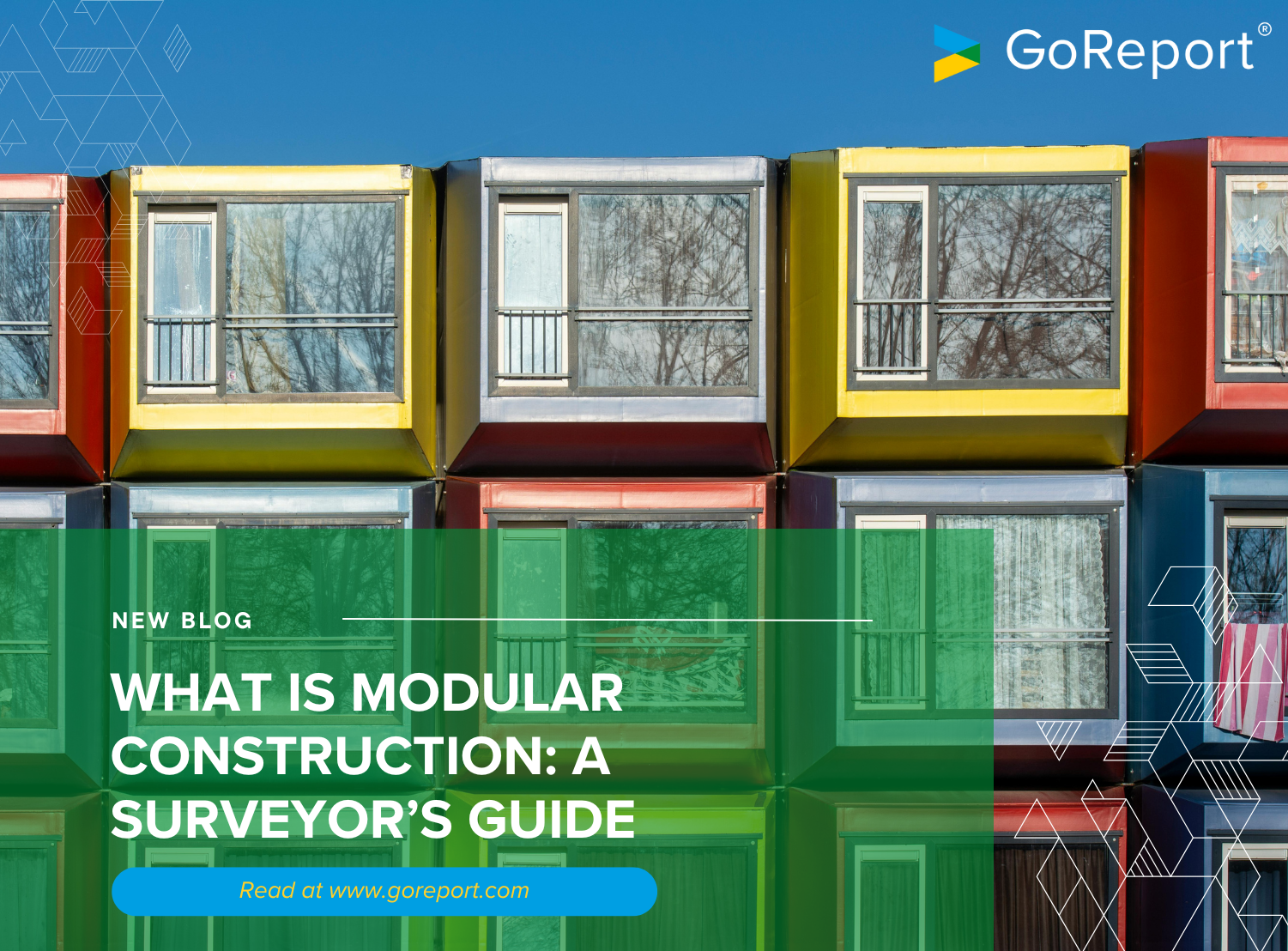What is Modular Construction: A Surveyors Guide

Modular construction has become a hot topic in housing, and for good reason. It promises faster delivery, reduced waste, and the potential to ease pressure on the housing shortage. But if you’re a residential surveyor, you may be asking yourself: what is modular construction, and why does it matter to me?
Whether you’re carrying out valuations, defect inspections, or snagging reports, understanding this method of building is no longer optional. Many clients will expect you to know how it works, what risks are involved, and how it differs from traditional bricks and mortar. This guide will walk you through everything you need to know.
Contents:
- What is modular construction?
- How modular differs from traditional building
- Volumetric construction vs modular construction
- The benefits of modular construction for surveyors
- The challenges you need to be aware of
- Common defects to look out for in modular homes
- Surveying Modular Homes: What You Need to Know
- Environmental due diligence and modular projects
- The role of digital data capture in modular surveys
- FAQs on modular construction
What is Modular Construction?
At its core, modular construction means creating a building in sections (modules) off-site, usually in a factory setting, before transporting and assembling them on-site. Unlike prefabricated homes of the past, modern modular construction is built to higher standards and is increasingly accepted by mortgage lenders. Each module comes complete with walls, floors, ceilings, and even fixtures before being pieced together like a jigsaw on site.
How Modular Construction Differs from Traditional Building
Traditional construction usually follows a sequence: lay foundations, build walls, add the roof, then install internal finishes. Modular flips this on its head by doing much of the work simultaneously in a controlled environment.
Key differences surveyors need to know:
- Speed of build: On-site programmes are often cut in half compared to traditional builds.
- Quality control: Factory settings allow tighter control over materials and workmanship.
- Foundation requirements: While the modules are pre-built, the groundworks and connections remain site-specific.
- Transport and craning: Moving large modules to the site introduces risks not usually found in standard construction.
It’s this different order of operations that changes how you, as a surveyor, approach the inspection and reporting process.
Volumetric Construction vs Modular Construction
The two terms are often used interchangeably, but they’re not quite the same.
- Volumetric construction usually refers to entire 3D units (bathrooms, bedrooms, kitchens) being manufactured and then stacked together.
- Modular construction can be volumetric, but it may also involve panelised systems where wall or floor sections are transported instead of full rooms.
If you’d like to understand this distinction in more depth, we’ve put together a dedicated guide on volumetric construction.
The Benefits of Modular Construction for Surveyors
So, why should surveyors care about modular construction? There are a few reasons:
- Client demand: More lenders and developers are backing modular homes, so surveyors will encounter them more often.
- Reduced site disruption: Faster builds can mean fewer access issues when scheduling inspections.
- Standardisation: Consistency in factory-built modules can make certain defects easier to identify.
- Data opportunities: Standardised builds also mean digital data capture tools can shine, helping you record and report findings more efficiently.
For surveyors, it’s less about inspecting a new style of building and more about adjusting your approach to match the way housing is now being delivered.
The Challenges You Need to Be Aware Of
Of course, modular construction isn’t all smooth sailing. There are some challenges worth flagging:
- Transport damage: Modules can crack, warp, or shift in transit.
- Moisture ingress: If modules aren’t properly sealed during installation, water penetration can cause long-term issues.
- Jointing problems: Where modules meet is often the weak point—movement cracks, thermal bridging, and sound transfer can all occur.
- Market perception: Despite progress, some buyers and lenders remain cautious about long-term durability.
This is where surveyors play a critical role: offering professional reassurance and identifying risks early before they become more permanent problems.
Common Defects to Look Out For in Modular Homes
When inspecting modular buildings, keep an eye out for:
- Gaps or cracking where modules join
- Poorly sealed external cladding
- Defective fire-stopping at junctions
- Inconsistent finishes (often due to rushed installation)
- Differential settlement where foundations don’t perfectly align with modules
Spotting these early and reporting them clearly can save your clients costly headaches later.
Surveying Modular Homes: What You Need to Know
Surveying a modular building isn’t the same as surveying a Victorian terrace or a 1990s semi. The fundamentals of condition assessment remain, but the method of construction means you’ll need to adjust your focus.
Key considerations for surveyors:
- Understand the build system: Before inspection, find out whether the property is panelised or volumetric, timber-framed or steel-framed. Each system has its own strengths and risk points.
- Check for certification: Look for accreditation such as BOPAS or NHBC warranties, which reassure lenders and buyers about long-term durability.
- Pay attention to transportation history: Was the home craned into place recently? Transport and lifting can leave behind damage not visible in factory QA checks.
- Focus on connections and interfaces: These are often the areas where defects occur, whether that’s between modules, foundations, or service link-ups.
- Use digital tools for accuracy: Modular homes often come with a high expectation for precision. Digital data capture and structured reporting, like those offered by GoReport, help ensure no detail is missed.
- Client communication: Some buyers may still be wary of modular homes due to outdated associations with post-war prefabs. Your role includes not just identifying issues, but explaining them clearly and reassuring clients with evidence.
Surveying modular construction is about striking a balance: applying your traditional surveying knowledge while adapting to the quirks of a factory-first building process. Done well, it positions you as an informed, forward-thinking professional in a housing market that’s moving quickly.
Environmental Due Diligence and Modular Projects
One of the headline advantages of modular construction is its reputation for being more sustainable. Less waste, controlled factory conditions, and fewer vehicle trips to site all support the industry’s push toward greener building practices. That doesn’t mean environmental risk disappears the moment you shift to modular, however.
Surveyors still need to apply the same due diligence as they would with any traditional build. Key areas to consider include:
- Contaminated land: Even if modules are manufactured off-site, the plot itself could carry historic contamination from industrial or agricultural use.
- Flood risk and drainage: Modular homes may arrive watertight, but inadequate flood resilience or poor drainage design can still compromise long-term performance.
- Material sourcing: Many modular systems rely on engineered timber or lightweight steel. Understanding the supply chain – whether materials are responsibly sourced, recyclable, or compliant with environmental standards – remains essential.
- Energy performance: While factory conditions often allow tighter tolerances, surveyors should still check for thermal bridging, airtightness, and renewable integration.
- Waste management on-site: Modular projects reduce construction waste, but groundworks and installation still generate spoil and packaging that require proper disposal.
This is where surveyors can add real value: by highlighting not just physical defects but also the environmental risks that could affect compliance, sustainability targets, or lender confidence. For a deeper breakdown of how to approach these assessments, our guide to environmental due diligence sets out the essentials.
The Role of Digital Data Capture in Modular Surveys
Surveyors working with modular projects need reporting processes that are as efficient as the construction itself. That’s where digital data capture becomes indispensable.
Instead of juggling endless photos, notes, and snagging lists, surveyors can use GoReport’s software to create structured, professional reports on-site. It makes identifying joint defects, recording factory-fit details, and communicating risks far easier and faster.
If you’d like to see how digital reporting could streamline your workflow, you can book a free demo with GoReport.
FAQs on Modular Construction
What is modular construction in simple terms?
It’s a way of building where most of the work is done in a factory, then the finished sections are transported and assembled on-site.
What are the three types of modular construction?
Modular construction generally falls into three categories: volumetric modules (3D units such as entire rooms built off-site), panelised systems (flat sections like walls, floors, or roofs transported and assembled on-site), and hybrid systems (a mix of volumetric and panelised, combining factory precision with on-site flexibility).
Is modular the same as prefabricated housing?
Not quite. Prefabs often had poor reputations due to post-war shortages. Modular today uses modern technology and stricter quality standards.
Are modular homes mortgageable?
Yes, many lenders now accept modular homes, provided they meet recognised build standards such as BOPAS.
What defects should surveyors look out for in modular homes?
Focus on joints between modules, sealing of cladding, and potential damage from transport or installation.
Does modular construction affect property value?
Market perception varies, but as adoption grows, modular homes are increasingly seen as reliable long-term assets.
Is modular construction eco-friendly?
Yes, modular construction is often considered more environmentally friendly than traditional methods. Factory production reduces waste, improves recycling rates, and minimises transport emissions by cutting down site trips. That said, eco-performance also depends on material choice, energy efficiency measures, and how the building is managed over its life cycle.
What is the lifespan of a modular building?
Modern modular buildings are designed to meet the same durability standards as traditional housing. With proper maintenance, they can last 60 years or more, and many come with BOPAS accreditation or NHBC warranties that provide lender confidence in their longevity.
Are modular buildings temporary?
Not at all. While modular techniques are sometimes used for temporary classrooms or site offices, the majority of modular housing in the UK is permanent and mortgageable. The misconception comes from older post-war prefabs, but today’s modular homes are built to meet national building regulations just like traditional ones.
Are modular buildings worth it?
For many developers and homeowners, yes. Modular offers faster build times, consistent quality, and often lower lifetime running costs thanks to energy-efficient design. For surveyors, they present a growing market to stay informed on. That said, “worth it” will always depend on factors like location, build quality, and the buyer’s long-term plans.








